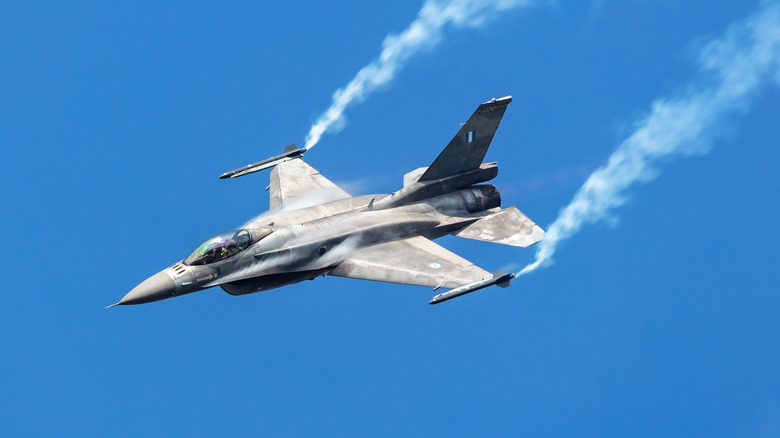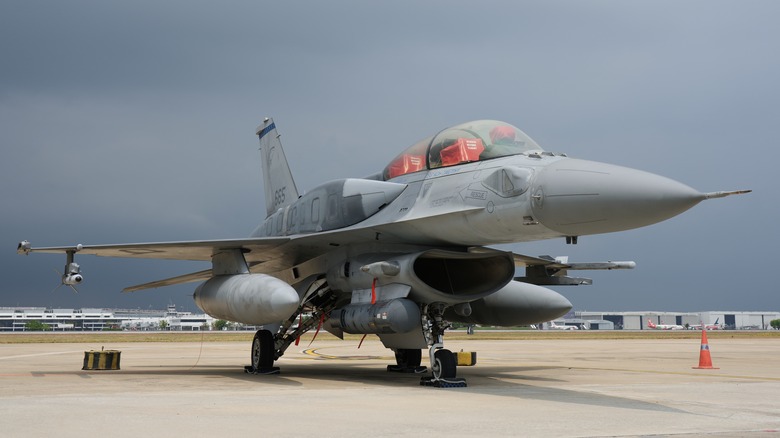F-16 Fighting Falcon Top Speed: How Fast Is The Fighter Jet?
The F-16 Fighting Falcon is highly regarded because of its remarkable maneuverability, combat radius, and multi-role capabilities. With its cutting-edge technological features, air-to-air engagement capabilities, and ongoing updates, the F-16 is a powerful and versatile frontline fighter aircraft. With a range of 1,345 miles and a ceiling height of 55,000 feet, the F-16 is considered a medium-range fighter compared to the other teen-series fighters, like the legendary F-15 Eagle or the F-18 Hornet, both long-range aircraft. Despite its shorter range, the F-16 is still fast and formidable, with the ability to reach a top speed of Mach 2, or twice the speed of sound.
The F-16 can attain this speed because of its powerful engine, which differs depending on the model or block. The block 30 F-16 has the General Electric Aviation F110-GE-100, producing 29,000 pounds of thrust; a block 32/42 will have the Pratt & Whitney F100-PW-220, rated at 24,000 pounds; finally, a block 50 will have a General Electric F110-GE-129, giving 29,000 pounds of thrust. These powerful engines, combined with the fighter's low weight of just 29,896 pounds loaded, give the F-16 a high thrust-to-weight ratio of 1.06 to 1.09, allowing it to accelerate and climb quickly.
Alongside its speed, the F-16 is also highly agile, a direct result of how it was designed to be unstable. The F-16 was also the first fly-by-wire fighter, with an onboard computer constantly making adjustments to address said instability. In addition, features like strakes to enhance vortex lift, variable-camber wings for better handling, and a slim, cropped-delta wing with a 40-degree leading-edge sweep combine to make the F-16 a very maneuverable and challenging opponent for enemy aircraft to engage.
Old but still gold
The development of the F-16 began in the 1970s when the United States Air Force started the lightweight fighter program. This later evolved into a low-cost air combat fighter program, which was meant to address the high cost of production of the now-retired Grumman F-14 Tomcat and the F-15 Eagle. A team of engineers and defense analysts from General Dynamics submitted their proposal for a lightweight dogfighter using the principles of energy maneuverability theory. General Dynamics's YF-16 and the Northrop YF-17 were chosen as finalists, with the YF-16 announced as the winner in January 1975.
Now manufactured by Lockheed Martin, the F-16 is one of the most successful and widely produced fighter jets. The U.S. Air Force has the most in its fleet, with 25 other countries also using the fighter. Since 1976, 4,600 F-16s have been built, and roughly 2,600 are still in service today. Regardless of the many newer fighters available today, the F-16 Fighting Falcon remains popular due to its low cost and proven effectiveness. This is why many countries consider it a cost-effective option for military aircraft acquisition.
Despite being 50 years old, the continuous development and upgrades to the F-16 have allowed it to remain relevant and competitive in terms of performance and capability. Its newest variant, the F-16V Viper, features the latest in avionics, radar, and cockpit technology. It shares software and hardware with the F-35 and also supports the Link-16 data network. To date, the F-16 Fighting Falcon is still one of the best fighter jets in the world and is poised to continue being so for many years.

